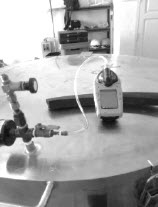Application of Photocatalytic Oxidation Technology in an Air Purifier for Benzene Removal by Using TiO2/PLA Film
Keywords:
Air purifier, Benzene, Photocatalytic oxidation, Poly lactic acid film, Responsive surface methodAbstract
The objectives of this research were to synthesize a catalyst from TiO2 embedded on a bio-composite film through photocatalysis application to benzene removal in 785 litre of air through photocatalyzed oxidation process in Air Purifier. And found out the best of benzene volatile organic compound removal condition with Box-Benkhen design’s respond surface method. The scope of the study was tested on three polylactic acid biopolymer films with the volume of TiO2 at 5.0, 10.0 and 15.0%w/w formed by molding film method. The morphology of the film was examined by scanning electron microscope. The chemical structure of the film was scanned by X-Ray diffraction. Light absorbance was detected by UV/VIS Spectrophotometer. After SEM testing, it was found that TiO2 on the three films were equally distributed and embedded all over the films. The crystal structure of Titanium dioxide was appeared to be an anatase structure. It was found that the energy gap was from 3.14 to 3.22 eV. The result can be confirmed the decrease of benzene compound after photocatalyzed oxidation process on photoreactor consisted of 785 litre of air. The result was shown that the light intensity at 5.24 mW/cm2 and TiO2 at 10.0%w/w can yield the optimum result at 62.28% of benzene compound decrease with initial intensity at 5±0.5 ppm. The most appropriate conditions to remove benzene volatile organic compound with Box-Benkhen design’s respond surface method were 5.24 mW/cm2 of light intensity, 10.0%w/w of TiO2, and 5±0.5 ppm of benzene initial intensity. With these conditions, the result revealed that the reaction rate was 58.90% at R2 0.82. Therefore, the concluded that the process of benzene volatile organic compound removal can be further developed in the form of equipment as air purifier with optimum condition.
References
Ao, Y., Xu, J., Fu, D., Shen, X., & Yuan, C. (2008). Low temperature preparation of anatase TiO2-coated activated carbon. Colloids and Surfaces A: Physicochemical and Engineering Aspects, 312(2-3), 125-130.
Cao, L., Gao, Z., Suib, S. L., Obee, T. N., Hay, S. O., & Freihaut, J. D. (2000). Photocatalytic oxidation of toluene on nanoscale TiO2 catalysts: Studies of deactivation and regeneration. Journal of Catalysis, 196(2), 253-261.
Destaillats, H., Sleiman, M., Sullivan, D. P., Jacquiod, C., Sablayrolles, J., & Molins, L. (2012). Key parameters influencing the performance of photocatalytic oxidation (PCO) air purification under realistic indoor conditions. Applied Catalysis B: Environmental, 128, 159-170.
Farhanian, D., Haghighat, F., Lee, C.-S., & Lakdawala, N. (2013). Impact of design parameters on the performance of ultraviolet photocatalytic oxidation air cleaner. Building and Environment, 66, 148-157.
Kreetachat, T., Kruenate, J., & Suwannahong, K. (2013). Preparation of TiO2/Bio-composite film by sol-gel method in VOCs photocatalytic
degradation process. Applied Mechanics and Materials, 390, 552-556.
Ray, S., Lalman, J. A., & Biswas, N. (2009). Using the Box-Benkhen technique to statistically model phenol photocatalytic degradation by titanium dioxide nanoparticles. Chemical Engineering Journal, 150(1), 15-24.
Roschan, S., & Tipayarom, A. (2014). Health risk assessment of exposure to volatile organic compounds emitted from photocopiers. In The
Graduate Research Conferences (pp. 971-976). Khon Kaen: Khon Kaen University.
Shifu, C., Wei, Z., Sujuan, Z., & Wei, L. (2009). Preparation, characterization and photocatalytic activity of N-containing ZnO powder. Chemical
Engineering Journal, 148(2-3), 263-269.
Suwannahong, K., Liengcharernsit, W., Sanongraj, W., & Kruenate, J. (2012). Appliaction of nano-TiO2/LDPE composite film on photocatalytic
oxidation degradation of dichloromethane. Journal of Environmental Biology, 33(5), 955-959.
Zhao, J., & Yang, X. (2003). Photocatalytic oxidation for indoor air purification: a literature review. Building and Environment, 38(5), 645-654.













